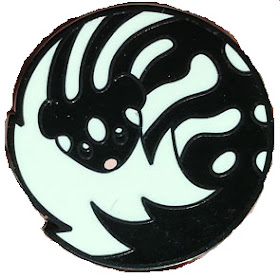Juliann Schamel has been researching island fox diet using stable isotopes in whisker samples since 2018. Friends of the Island Fox has supported the processing of whisker samples through several Research Grants. In November of 2023, Schamel presented the following poster of her latest work at the California Islands Symposium.
Using Stable Isotopes to Assess a Decade of Dietary Resource Use in Two Sympatric Island Endemics: The Island Fox and the Island Spotted Skunk (link to complete poster)
Island foxes and island spotted skunks live together on two islands, Santa Rosa and Santa Cruz. When island fox numbers crashed due to predation by golden eagles, island spotted skunk numbers appeared to increase dramatically. In 2011, on Santa Rosa Island, there were still fewer than 90 island foxes in the wild. During annual health checks, whisker samples were collected from both island foxes and island spotted skunks in a northern area of the island and stored for later analysis of what food resources each species was using.
In 2011, island spotted skunks out numbered island foxes in the wild. Stable isotope analysis shows that the skunks and foxes were using different resources.
 |
| J. Schamel, 2023 poster |
Carbon and nitrogen isotopes travel up the food chain leaving a specific isotope signature for plant and animal resources. Literally, you are what you eat and isotopes from a mammal's diet are laid down chronologically in hair or fur. A single island fox whisker can provide 5–6 months of weekly diet data. On the graph above, native terrestrial plant foods, like manzanita berries, are high in Carbon and low in Nitrogen. A deer mouse is the accumulation of its own, mostly plant diet; it has a mid-range Carbon and Nitrogen signature. In the graph above, the blue data points represent island fox diet and the orange data points represent island spotted skunk diet.
In 2011, when island fox numbers in the wild were low, their diet tended
to be higher on the food chain or trophic level: deer mice, birds and
reptiles. The data suggested separate diet niches for island foxes and island
spotted skunks. The skunks were eating primarily, lower level prey, like insects, and some plant foods.
 |
| J. Schamel, 2023 poster |
In 2014, continuing drought influenced wildlife survival; island fox and island spotted skunks were nearly even in number on Santa Rosa Island. Island foxes expanded their diet, including marine resources, and island spotted skunks preyed more on deer mice and higher level prey. The two predators began competing for resources.
 |
| J. Schamel, 2023 poster |
By 2018, the island fox population had recovered, but island spotted skunks appeared to decline in number. (Counting island spotted skunks) As island fox density increased across the island, they dramatically broadened their diet–from native fruit through a range of prey species. The spotted skunks maintained a more narrow diet, but they were now in constant competition with island foxes. What will this mean for the two species?
Schamel's work also revealed that individual island foxes are becoming specialized in their diet.
In the graphic above, each circle of data points represents an individual island fox and its diet. Some individuals appear to be specializing in fruit and insects, while others are eating predominately terrestrial prey. How is island fox diet continuing to change?
Save the date of April 30th at 6:30 pm PT
Juliann Schamel will talk about her work on
FIF's "Date with a Fox" webinar
sign-up for FIF's e-newsletter to receive an invitation
 |
| Measuring out a whisker sample |
Whisker samples continue to be collected for both species.
 |
| designed by island biologist, Stacy Baker |
When you purchase an island spotted skunk pin,
you send a sample of island spotted skunk whisker
to the mass spectrometer to reveal stable isotopes.



